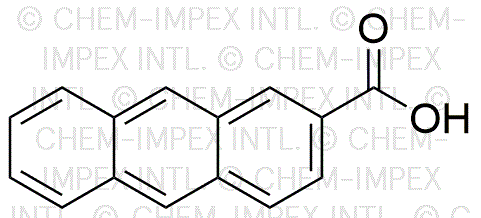2-Anthracenecarboxylic acid is widely utilized in research focused on:
- Organic Synthesis: This compound serves as a key building block in the synthesis of various organic materials, including dyes and pharmaceuticals, due to its stable structure and reactivity.
- Fluorescent Probes: Its unique fluorescence properties make it an excellent candidate for developing fluorescent probes used in biological imaging and detection methods.
- Polymer Chemistry: It can be incorporated into polymers to enhance their optical properties, making it valuable in the production of advanced materials for electronics and coatings.
- Research in Material Science: The compound is studied for its potential in creating new materials with specific electronic and optical characteristics, which can lead to innovations in sensors and solar cells.
- Pharmaceutical Applications: Its derivatives are explored for potential therapeutic uses, particularly in cancer research, due to their ability to interact with biological systems effectively.
Información general
Propiedades
Seguridad y normativas
Aplicaciones
2-Anthracenecarboxylic acid is widely utilized in research focused on:
- Organic Synthesis: This compound serves as a key building block in the synthesis of various organic materials, including dyes and pharmaceuticals, due to its stable structure and reactivity.
- Fluorescent Probes: Its unique fluorescence properties make it an excellent candidate for developing fluorescent probes used in biological imaging and detection methods.
- Polymer Chemistry: It can be incorporated into polymers to enhance their optical properties, making it valuable in the production of advanced materials for electronics and coatings.
- Research in Material Science: The compound is studied for its potential in creating new materials with specific electronic and optical characteristics, which can lead to innovations in sensors and solar cells.
- Pharmaceutical Applications: Its derivatives are explored for potential therapeutic uses, particularly in cancer research, due to their ability to interact with biological systems effectively.
Documentos
Hojas de datos de seguridad (HDS)
La SDS proporciona información de seguridad completa sobre la manipulación, el almacenamiento y la eliminación del producto.
Especificación del producto (PS)
La PS proporciona un desglose completo de las propiedades del producto, incluida la composición química, el estado físico, la pureza y los requisitos de almacenamiento. También detalla los rangos de calidad aceptables y las aplicaciones previstas del producto.
Certificados de análisis (COA)
Busque certificados de análisis (COA) ingresando el número de lote del producto. Los números de lote y de partida se pueden encontrar en la etiqueta de un producto después de las palabras "Lote" o "Lote".
Número de catálogo
Número de lote/lote
Certificados de origen (COO)
Este certificado de origen confirma el país en el que se fabricó el producto y también detalla los materiales y componentes utilizados en él y si se deriva de fuentes naturales, sintéticas u otras fuentes específicas. Este certificado puede ser necesario para cumplir con las normativas aduaneras, comerciales y regulatorias.
Número de catálogo
Número de lote/lote
Hojas de datos de seguridad (HDS)
La SDS proporciona información de seguridad completa sobre la manipulación, el almacenamiento y la eliminación del producto.
DownloadEspecificación del producto (PS)
La PS proporciona un desglose completo de las propiedades del producto, incluida la composición química, el estado físico, la pureza y los requisitos de almacenamiento. También detalla los rangos de calidad aceptables y las aplicaciones previstas del producto.
DownloadCertificados de análisis (COA)
Busque certificados de análisis (COA) ingresando el número de lote del producto. Los números de lote y de partida se pueden encontrar en la etiqueta de un producto después de las palabras "Lote" o "Lote".
Número de catálogo
Número de lote/lote
Certificados de origen (COO)
Este certificado de origen confirma el país en el que se fabricó el producto y también detalla los materiales y componentes utilizados en él y si se deriva de fuentes naturales, sintéticas u otras fuentes específicas. Este certificado puede ser necesario para cumplir con las normativas aduaneras, comerciales y regulatorias.


